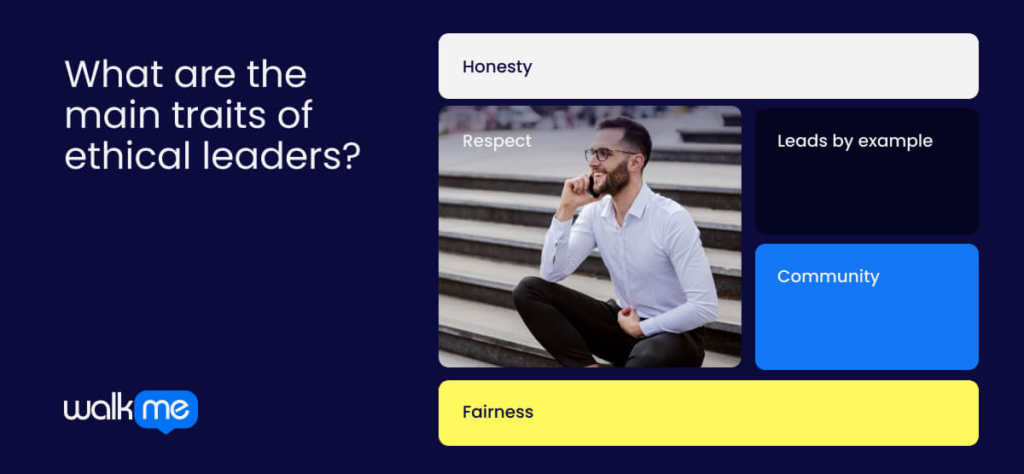For a manager, the difference between being a boss and a leader is clear. A boss gives orders; a leader guides. A boss manages; a leader inspires. The key difference lies in how they better the employee experience.
A good leader improves employee engagement by guiding and inspiring them. They lead by example and practice ethical leadership. Ethical leaders create respect and a safe work environment, making employees feel valued and supported.
This article will explain ethical leadership and its traits. Next, we will examine examples, best practices, and the pros and cons.
What is ethical leadership?
Ethical leadership is the practice of showing good behavior both in and out of the office. It focuses on doing what’s right, with honesty, fairness, and transparency guiding decisions.
These leaders act on their values and never ignore wrongdoing, even if it helps their business. Integrity is key to their actions, and they set a positive example for others.
Being an ethical leader builds credibility and a strong reputation. Unethical behavior harms both personal and company brands. It can also lower self-esteem and prevent leaders from reaching their full potential.
What are the main traits of ethical leaders?

The main characteristics of ethical leaders are:
Honesty
Ethical leaders need to communicate well to build and maintain trust. They should be open and honest about all issues, no matter how serious or unpopular. Clear and straightforward communication helps others make better decisions.
Being honest and transparent also improves a brand’s reputation. This can lead to long-term customer loyalty.
Respect
Respect has many meanings, but it mainly involves recognizing the wishes, feelings, and rights of others. As an ethical leader, you may not agree with everyone’s feelings, but you should respect them. People have their reasons for being who they are. True understanding means respecting our differences, even if you don’t agree with them.
Leads by example
These leaders hold themselves to the same standards as their team. Ethical leaders support their employees with daily tasks, helping them understand their work and challenges. This allows leaders to guide their employees effectively.
Ethical leaders set a strong example by showing integrity and honesty in their work. When employees see their leaders making ethical choices, they are likelier to do the same.
Community
Ethical leaders value each person, but they also see how important connections are. To build a strong community, they consider how their choices affect everyone. This includes investors, employees, customers, and partners. When needed, ethical leaders are willing to put others first to help the team or organization.
Fairness
Ethical leadership involves making tough decisions and negotiations. Ethical leaders focus on long-term success, not just short-term gains. They support fairness and merit, treating everyone equally regardless of status, ethnicity, age, or other differences.
Being fair means giving equal opportunities without favoritism. It also means condemning bad behavior, manipulation, or actions that could hurt others.
What are some examples of ethical leaders?
Here are some important examples of ethical leaders:
Rose Marcario
When Rose Marcario became CEO of Patagonia in 2014, she strengthened the company’s values. While achieving financial success, she fought to protect public lands. She also launched Patagonia Action Works to help customers get involved in environmental and social activism.
Marcario encouraged people to repair or exchange their clothes instead of buying new ones. Patagonia also made headlines by suing the Trump administration over reducing two national monuments. The company also supported bipartisan efforts, including giving employees time off to vote and endorsing environmentally conscious candidates.
Blake Mycoskie
In 2006, TOMS Shoes changed the way people think about for-profit businesses. The company’s founder, Blake Mycoskie, created a simple idea called the One for One model: for every item sold, one is given to someone in need.
Mycoskie got the idea during a trip to Argentina. He noticed the popular Alpargata shoes and saw that many children couldn’t afford shoes. This inspired him to create a business to help.
He believed that for every pair of shoes sold in Venice, California, he would give a pair to disadvantaged kids who needed them for school. This led to the creation of TOMS, short for ‘Tomorrow’s Shoes’.
David Neelman
In 2007, JetBlue faced canceled and delayed flights, upsetting many passengers. CEO David Neeleman apologized and created a “customer bill of rights” offering compensation for delays and overbooking.
Neeleman took full responsibility, reaching out to 131,000 affected customers. Passengers stuck for over three hours received a refund and a free flight voucher. Known for thinking differently, Neeleman has founded five airlines, with disruption being central to his approach.
What are the best practices to apply ethical leadership?

The top best practices for applying ethical leadership in your workplace are:
Hire people who will follow the right values
Your values don’t have to match those of your workers, but you should find common ground. This often starts during the hiring process and continues with a vision statement. No one wants to work for someone who doesn’t share their values.
Without mutual respect, building a strong team is hard. Most people struggle to respect someone with different values. Your ethical values should align across all business operations.
To determine the right values, ask yourself what matters to you. Align that with your priorities as a leader. Defining your values shows your true self and encourages your team to do the same.
Set clear standards
Ethical leadership requires clear standards and expectations for the team. Leaders must ensure everyone knows the organization’s mission, vision, values, and goals. Clear standards help everyone stay on the same ethical page and act honestly.
If someone breaks the rules and the leader does nothing, it may seem that these standards aren’t important. Ethical leaders do not make exceptions. They quickly show which behaviors are not acceptable, building consistency and credibility and preventing confusion about accepted behavior.
Recognize the value of all employees
Great leaders create an environment where everyone feels included. Teamwork helps everyone make progress. Each member feels valued for their skills.
Instead of focusing only on competition, an ethical leader ensures that their team feels supported by one another.
By showing kindness, empathy, vulnerability, and honesty, ethical leaders encourage others to do the same. Leadership means being a role model and creating a comfortable environment for all.
Get comfortable with unpleasant situations
As an ethical leader, discomfort can help you learn to trust your instincts.
Be aware of situations that lead to ethical dilemmas, like hiring, firing, and promotions. These often create tough choices. A threat to your image or income can cloud your judgment. Your conscience will signal when something feels wrong.
If a situation makes you uncomfortable, pause and think. Visualizing different scenarios can help you decide. In a crisis, you may have only seconds to act, so practice is helpful.
You can also do this exercise with your team to prepare them for ethical dilemmas. If you’re unsure about a decision, think about how you would feel if it were public. Would you be proud of it? If not, rethink your choice.
What are the benefits of ethical leadership?
The most important benefits of ethical leadership are:
Improves the workplace culture
Ethical leaders inspire their teams to do their best. They help employees feel like important parts of the company’s culture. When employees know they work for an ethical leader who cares, morale and productivity improve.
A culture built on ethics attracts top talent and increases employee engagement. It also strengthens the company’s reputation and sets it up for long-term success.
Betters employee loyalty
When employees know their leaders are fair, honest, and open, they feel more engaged and at home at work.
Hiring, training, and keeping talent is expensive. Ethical companies improve job satisfaction, which helps them financially. Ethical leadership also helps attract and keep employees. People are naturally drawn to companies that share their values.
Strengthens the company’s reputation
An ethical leadership style affects a company’s reputation. Ethical behavior makes customers and businesses see the company in a positive light.
Other businesses notice the loyalty of employees and customers. They try to copy the success of an ethical leader. When leaders act with integrity, they show the company in the best way. They make decisions that help both employees and customers, building a reputation for doing what’s right.
These types of leaders don’t create bad PR. By sticking to values and leading by example, they avoid hurting the company’s reputation.
What are the challenges of implementing ethical leadership?
The main challenges of implementing ethical leadership are:
Getting over your own biases
As humans, we often have wrong or outdated beliefs, whether we know it or not. No leader likes to admit their flaws. However, not being self-aware can cause harm.
As an ethical leader, it’s important to recognize your biases, ideas, and stereotypes in every situation and ensure that you do not treat people unfairly because of them.
Building and sustaining an ethical culture
The current workplace culture can make ethical leadership difficult. In harsh environments, employees may fear speaking up about ethical issues. They might worry about being ignored or even fired.
A skilled manager may not be an effective ethical leader if they are introverted or unfriendly. Once you hire the right people, encourage an open-door policy to sustain an ethical leadership culture. This lets employees talk to supervisors about any concerns they have.
Choosing morality over what is right for the company
One of the biggest challenges ethical leaders face is choosing between making a moral decision or one that helps the company. Many people criticize ethical leadership because doing what’s right can sometimes hurt the business.
Balancing ethics and business decisions can be hard. For example, you might need to fire an employee who isn’t helping the company. You know he is the main earner in his family, and his wife is pregnant.
This makes it morally hard to let him go, even though it’s best for the business.
Use an ethical leadership approach to encourage your employees to always do the right thing
Ethical leadership means making decisions based on what’s right for everyone, not just for personal or company gain.
While profits are important, ethical leaders also consider the needs of customers, employees, and the community. They encourage their teams to do the same. This creates a culture of transparency, teamwork, and inclusion, where everyone feels safe to speak up.
In the short term, ethical leadership boosts employee morale and positivity. In the long term, it helps prevent scandals, attracts customers, and builds employee loyalty. This leads to lasting success for the business.
FAQs
Ethical leadership works well when you want to create a workplace where employees feel supported and motivated to succeed. It often follows a servant approach, focusing on helping the team rather than leading from the front.
Ethical leadership is important as it improves employee morale, builds the brand image, improves workplace culture, and strengthens customer loyalty.

